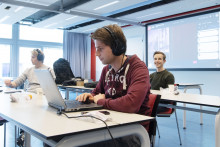In education, every organisational choice we make is ultimately driven by the question of what is of the greatest benefit to the largest number of students. This is by no means an easy criterion to apply, and discussions can get quite hot; but it is a positive one, and the process of getting there can be rewarding in itself.
Sometimes, however, it is more appropriate to think in terms of harm than benefit. Sometimes, whatever you decide will harm some students. Then it becomes a question of what does the least harm to the fewest. This is a much darker type of discussion. The mood grows grim. How can you quantify harm in the first place? How can you harden yourself to accept short-term harm to avoid long-term disaster? How do you balance these factors, and how can you justify your decisions to those students harmed by them?
One such issue is now on the table. It involves enabling students to take part in education online; including those activities that are actually scheduled to take place on campus. At a time when we ask our students to stay at home at the slightest suspicion of infection, how can we fail to pull out all stops to allow them to continue their studies? If for our students the penalty for delay is premature eviction, surely we must do our utmost to prevent harm by recording all lectures, organising hybrid teaching activities as well as resit after resit, and answering all email, Teams, Slack, Canvas and Discord messages within the day?
And yet there is harm in this as well, of a more subtle nature. As it becomes easier to stay at home and believe you are still studying effectively, so one of the forces that drives our students to get up in the morning and get going is weakening; and so we are losing out on two out of the three functions that higher education is commonly said to have, while the third is in grave danger. Socialisation: learning how to function as part of a larger whole. Formation: getting to know and developing yourself as a person. Qualification: acquiring knowledge and skills in your chosen field of study. Only the third function is served by attending education online, and this gets weaker by the week as our students are lonelier, more depressed and more stressed than ever before, for lack of the first two.
Further harm lies in the fact that upholding the online mode of education puts a burden on our teachers, and can hardly do anything but decrease the quality of their delivery. Having to cater for online and on-campus students simultaneously is not at all easy, and even switching on a camera, ensuring it is working properly, staying within its field of vision and hearing, and afterwards processing the recording with all the care that privacy regulations demand, requires attention that is better given to the actual contact with the students present.
What then, I hear you say. Do we abandon online education altogether? Certainly not: for some activities, online is an excellent mode; let’s not throw out the baby with the bathwater. Hybrid education though, the streaming or recording of all lectures by university policy, the now default practice of re-re-sits ad infinitum: should we abandon that? Let’s put it on the table! Anything to get on-campus attendance back to more than 10%. Let’s listen to those teachers and programme directors who are starting to speak of a lost generation of students, students who never got to enjoy student life to the fullest, and so never learned, never truly learned, that the campus is where everything really happens.
Which is greater: the harm we do by insisting that all students return to campus, or the harm we do by keeping the hybrid option alive? Where does the balance lie? I’m sure I don’t know. I’m sure there is no good solution: it’s a matter of the lesser evil. I’m sure it depends on the student as well as the study; all of the above relies on coarse generalisations. However, I am also sure of this: the harm we do by suggesting that our hybrid education is good enough to stay at home for is growing, quarter by quarter.










